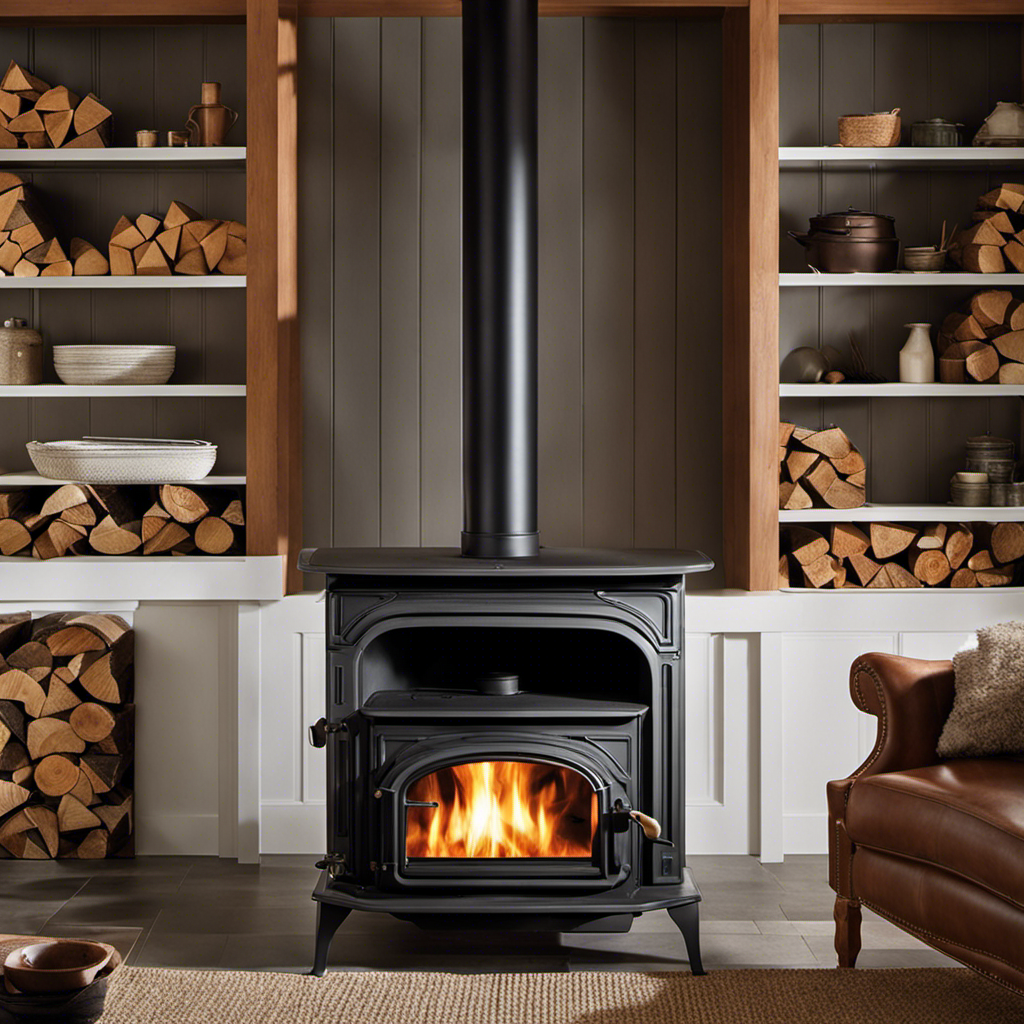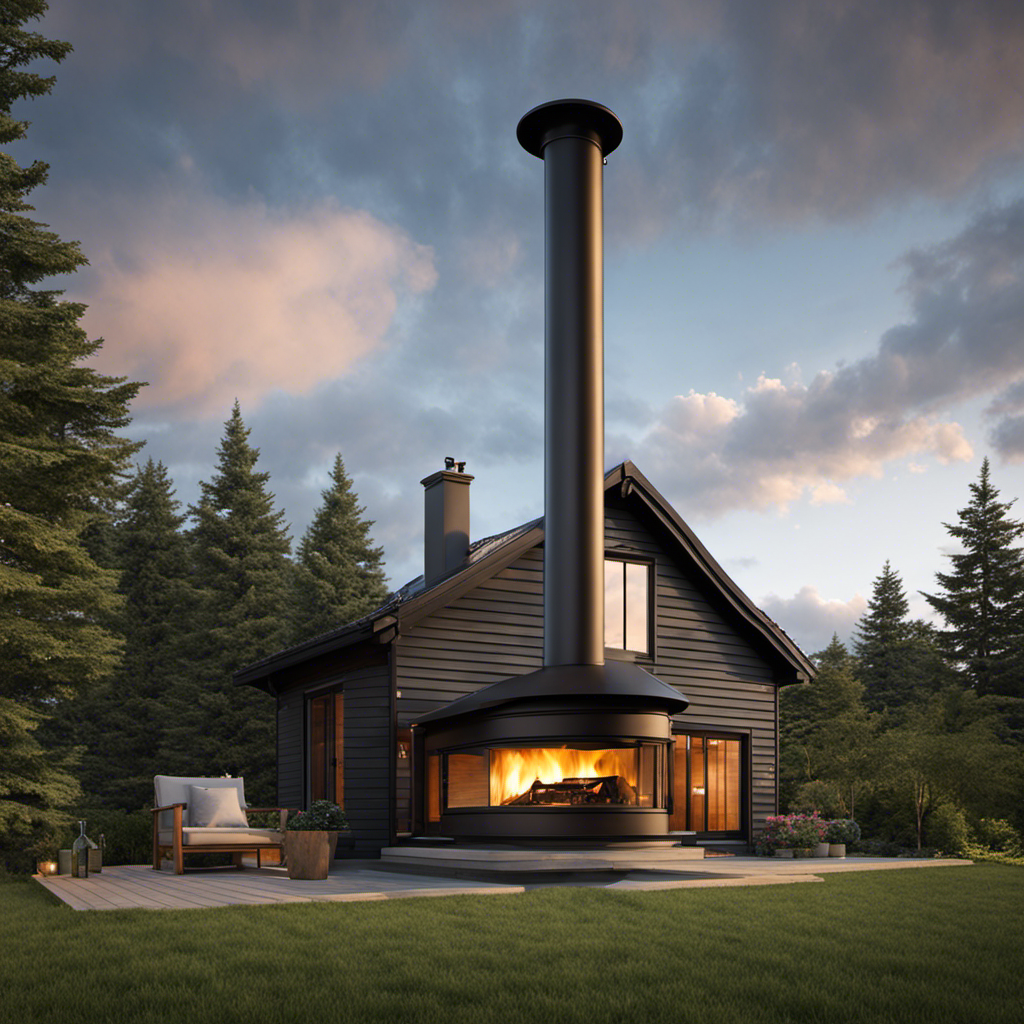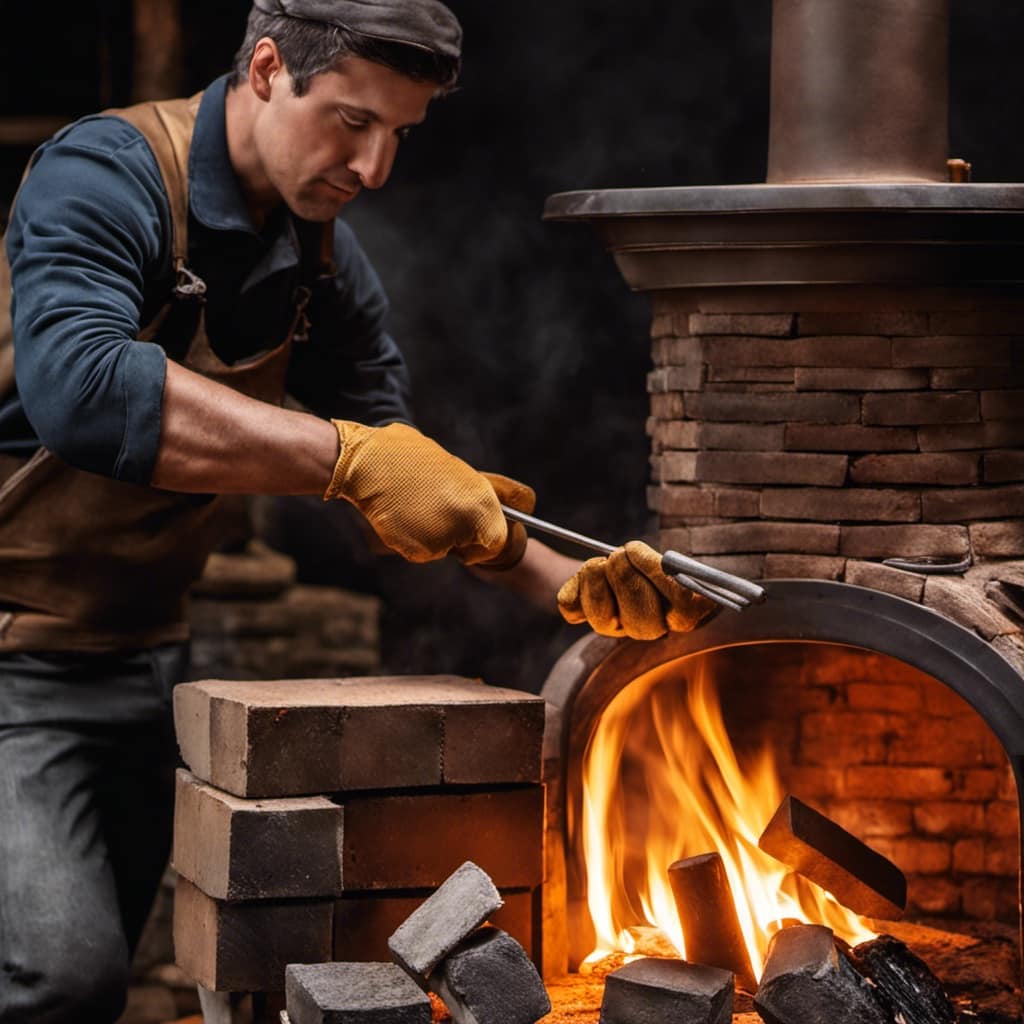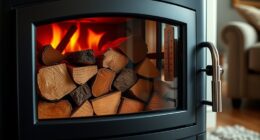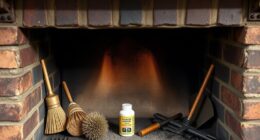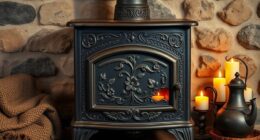Were you aware that incorporating a refractory board into your wood stove can markedly enhance its efficiency? Indeed, it is true!
With its heat-resistant properties, a refractory board acts as a barrier, protecting your wood stove from extreme temperatures and preventing damage.
Not only does it enhance the heat efficiency of your stove, but it also ensures a longer lifespan.
In this article, I’ll delve into the benefits of a refractory board and provide helpful tips for choosing and maintaining the right one for your wood stove.
Key Takeaways
- Provides insulation and retains heat generated by the wood stove
- Acts as a thermal barrier, preventing heat escape and reducing energy wastage
- Regulates and maintains consistent temperature inside the stove
- Protects interior components, extending the lifespan of the wood stove
The Purpose of a Refractory Board
I learned that the main purpose of a refractory board is to provide at least two layers of insulation for the wood stove. The benefits of using a refractory board are numerous.
Firstly, it helps to retain the heat generated by the wood stove, ensuring that it’s efficiently utilized to warm the surrounding area. Additionally, the insulation provided by the refractory board helps to prevent the escape of heat, reducing energy wastage and ultimately saving on heating costs.
There are various types of refractory materials that can be used for wood stoves, including ceramic fiber boards, calcium silicate boards, and vermiculite boards. Each type has its own unique properties, such as high-temperature resistance and excellent heat retention, making them suitable for different applications.
Ultimately, the use of a refractory board in a wood stove greatly enhances its performance and efficiency.
How a Refractory Board Protects Your Wood Stove
During colder months, a refractory board acts as a barrier and protects your wood stove from excessive heat, ensuring its longevity. The insulating properties of the board help to prevent heat damage to the stove and surrounding areas. This is achieved by absorbing and distributing the intense heat generated by the burning wood, thereby reducing the risk of overheating and potential fire hazards. The refractory board also acts as a thermal barrier, preventing heat from escaping through the walls of the stove and increasing its overall efficiency. Additionally, the board helps to regulate the temperature inside the stove, allowing for more controlled and efficient burning of wood. Overall, the presence of a refractory board is crucial for maintaining the safety and performance of your wood stove.
| Benefits of a Refractory Board | How it Works |
|---|---|
| Insulating properties | Absorbs and distributes heat |
| Preventing heat damage | Acts as a thermal barrier |
| Increasing stove efficiency | Regulates temperature |
| Ensuring safety | Reduces risk of fire hazards |
Enhancing Heat Efficiency With a Refractory Board
Using a refractory board in your wood stove can significantly enhance heat efficiency and reduce energy waste. Here’s how it works:
-
Insulation: A refractory board acts as insulation, preventing heat from escaping through the walls of the stove and maximizing heat output inside the stove.
-
Heat Reflection: The board reflects heat back into the firebox, increasing energy savings by ensuring that more heat is utilized for heating the room instead of being lost.
-
Heat Distribution: It helps distribute heat evenly throughout the stove, ensuring that all areas of the stove are heated efficiently.
-
Temperature Regulation: The board helps in regulating and maintaining a consistent temperature inside the stove, optimizing energy usage and reducing fuel consumption.
-
Protection: It protects the interior components of the wood stove from extreme temperatures, extending the lifespan of the stove and reducing maintenance costs.
Choosing the Right Refractory Board for Your Wood Stove
When selecting a refractory board for my wood stove, it’s essential to consider factors such as durability, heat resistance, and ease of installation.
A refractory board plays a crucial role in enhancing the insulation benefits of a wood stove. It acts as a barrier, preventing heat from escaping and ensuring maximum heat efficiency. The insulation properties of the board help maintain a consistent and controlled temperature inside the stove, resulting in more efficient burning and reduced energy consumption.
In addition to insulation benefits, durability is a key factor to consider when choosing a refractory board. It should be able to withstand high temperatures without cracking or deteriorating over time.
Ease of installation is also important for a hassle-free setup. Taking these factors into account will ensure that you select a high-quality refractory board that meets your needs.
Now, let’s explore some maintenance tips for a long-lasting refractory board.
Maintenance Tips for a Long-lasting Refractory Board
I’ve found that by regularly inspecting and cleaning around the refractory board, as well as applying a protective sealant, I can ensure its long-lasting performance. The refractory board plays a crucial role in a wood stove, providing insulation and protecting the surrounding components from excess heat.
To maximize its longevity benefits, here are some cleaning techniques I recommend:
- Use a soft brush or vacuum to remove any dust or debris that may accumulate on the board.
- Wipe the board with a damp cloth to remove any stubborn dirt or stains.
- Avoid using abrasive cleaners or harsh chemicals that can damage the board’s surface.
- Apply a high-temperature sealant to protect the board from moisture and prevent cracks.
- Regularly check for any signs of wear or damage and address them promptly to prevent further issues.
Frequently Asked Questions
How Much Does a Refractory Board Cost?
Refractory boards have various applications, and their cost can vary depending on factors such as size and quality. They offer advantages such as heat resistance and durability, making them a valuable addition to wood stoves.
Can I Install a Refractory Board in My Existing Wood Stove?
Yes, you can install a refractory board in your existing wood stove. Refractory boards have many advantages, such as increasing heat efficiency and protecting the stove from damage. There are different types of refractory boards available to suit your specific needs.
How Long Does a Refractory Board Typically Last?
Typically, a refractory board on a wood stove lasts around 5-10 years. Signs of deterioration include cracks, crumbling, or a decrease in heat retention. When these signs appear, it’s time to replace the board.
Are There Any Specific Safety Precautions to Take When Using a Wood Stove With a Refractory Board?
When using a wood stove with a refractory board, it is important to take safety precautions. Regular maintenance is also necessary to ensure the board remains in good condition and maximizes its heat-resistant properties.
Can a Refractory Board Be Used in Other Heating Appliances, Such as Fireplaces or Outdoor Ovens?
A refractory board can also be used in heating appliances like fireplaces or outdoor ovens. It offers similar benefits as firebrick, but with added advantages such as heat retention and durability.
Conclusion
In conclusion, a refractory board is like the armor of a wood stove, protecting it from the intense heat and ensuring its longevity.
By creating a barrier between the fire and the stove, it prevents damage and enhances the stove’s efficiency by reflecting and radiating heat.
Choosing the right refractory board and regularly maintaining it will ensure a long-lasting and efficient wood stove experience.
So, think of a refractory board as the trusty shield that keeps your wood stove strong and roaring.
Logan’s affair with adventure began in childhood. He hailed from a small town where vast forests bordered one side and endless shores stretched on the other. His days were spent exploring uncharted woods, climbing tall trees, or listening to the tales of old sailors. This early immersion in a world brimming with stories and mysteries became the foundation of his passion for writing.

